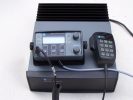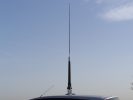|
Transceiver Codan 9360
Antenna Codan 9350
The transceiver Codan 9360
 |
Transceiver +
operational unit +
microphone
[ <-- Click ] |
was developed by the Australian company Codan , especially for the Autralian outback.
It virtually became a standard for UN- organisations.
The transceiver is meant for mobile and fixed station use.
There are two versions: with operational elements on the front plate. or with an extra
operational unit with loudspeaker. (This is the collection's version).
The version with a front plate optionally can be operated with three operational units.
The operational unit has 10 pushbuttons, 2 rotary knobs, and an LCD- display.
The number of storable channels depends on the type of transceiver, and the number of channel comments used.
 |
Operational unit and mikrophone
[ <-- Click ] |
Operational unit and mikrophone
do not erplace each other- they complement each other. For example, the radio
is switched on with the operational unit; The microphone is used for the numerical imput. Most operational steps can be made
with the two of them.
Channels can be stored as simplex or as two-frequency simplex.
Channels can be moved to different channel places; receive- only channels can be stored.
In scan- mode, up to 10 channels can be called up.
By using a special cable and the microphone connector, settings and frequencies can be cloned.
A special pin can be programmed, to release the operation of the radio.
The TRX is built as a channel- only radio, which limits its use asa HAM radio.
Any receive frequency can be chosen by clarifier, by pushing PTT the TRX jumps back to the last used
channel frequency. This specimen, however, has a freescroll option which overrides the channel function.
Now all frequencies can be tuned, and the TRX is a an excellent Ham transceiver.
The mobile antenna Codan 9350
 |
Antenna
[ <-- Click ] |
is remotely controlled by the transceiver. After chosing a new frequency, you press "tune", and the antenna tunes itself.
A step motor (operated by a microcontroller) in the antenna base compares the new frequency with the last frequency used
(stored in an Eprom), and computes the direction of the tuning.
The antenna consists of
a lower part, with the built in tuning mechanism.
The housing is made of glass fibre reinforced nylon, the fixing point is flexible.
The upper antenna part (1.58 m long) is a solid rod antenna, it can be removed when not in use.
The complete antenna length is 245 cm.
An Nvis- antenna can be got as accessories.
- Frequency range:
- Transceiver receiving: 250 kHz .. 30; transmitting: 2.25 .. 30 MHz
- Antenna receiving: 250 kHz .. 30; transmitting: 2.5 .. 27 MHz

Technical data transceiver:
- Frequency:
- transmitting: 2.25 .. 30 MHz
- receiving: 250 kHz .. 30 MHz
- Channels:
- up to 400 simplex- or 2-frequency- simplex- channels
- HF output:
- 125 or 80 W
- Sensitivity:
- (RF Amp on) 0,12 to 0,18 µV @ -122 dBm
- Frequency generated by:
- Synthesizer
- Frequency spacing:
- 10 Hz
- Warm up time:
- 1 min
- Antenna output:
- 50 Ohm
- Operational volzage, consumption:
- 13,6 V, standard 10,5 .. 15; maximum 9 .. 16 V; 9 .. 12 A
- Measurements and weight:
- 250 x 78 x 350 mm; 3,3 kg
Technical data mobile antenna:
- Frequency:
- transmitting: 2.5 .. 27 MHz
- receiving: 250 kHz .. 30 MHz
- HF- output:
- up to 125 W
- Consumption:
- Receiving 125 mA
- Transmitting 1 A
- Powerd by:
- 12V, supplied by the transceiver
- Tuning speed:
- Typical 2 Sec
- over the complete frequency 2 .. 27 MHz : 5,5 Sec
- Impedance:
- 50 Ohm
- Vsr:
- 1.5 : 1
- Modes:
- Scan- and Tune- mode
(both controlled by teh transceiver -
- by scan- and tune- buttons)
- Comnnections:
- Control cable + coax cable: each 6m long
- Weight:
- 5.8 kg
- Length:
- 245 cm
|